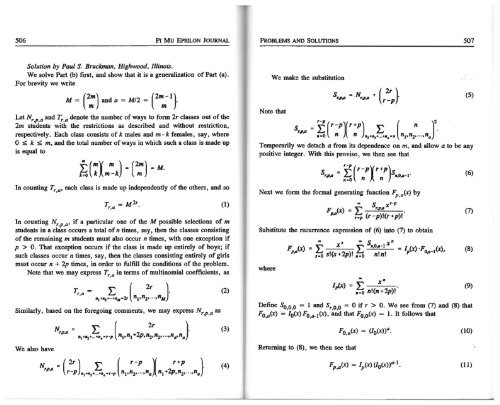Vol. 10 No 6 - Pi Mu Epsilon
Vol. 10 No 6 - Pi Mu Epsilon
Vol. 10 No 6 - Pi Mu Epsilon
- No tags were found...
You also want an ePaper? Increase the reach of your titles
YUMPU automatically turns print PDFs into web optimized ePapers that Google loves.
506 PI MU EPSILON JOURNAL<br />
PROBLEMS AND SOLUTIONS<br />
507<br />
Solution by PaulS. Bruckman, Highwood, Illinois.<br />
We solve Part (b) first, and show that it is a generalization of Part (a).<br />
For brevity we write<br />
M = ( 2 :) and a = M/2 = ( 2 mm-l}<br />
Let Nr,p,a and Tr,a denote the number of ways to form 2r classes out of the<br />
2m students with the restrictions as described and without restriction,<br />
respectively. Each class consists of k males and m - k females, say, where<br />
0 ~ k ~ m, and the total number of ways in which such a class is made up<br />
is equal to<br />
E (mY m ) =(2m) = M<br />
k=O k},m-k m ·<br />
In counting Tr,a• each class is made up independently of the others, and so<br />
T = M2r<br />
r,a •<br />
In counting Nr,p,a• if a particular one of the M possible selections of m<br />
students in a class occurs a total of n times, say, then the classes consisting<br />
of the remaining m students must also occur n times, with one exception if<br />
p > 0. That exception occurs if the class is made up entirely of boys; if<br />
such classes occur n times, say, then the classes consisting entirely of girls<br />
must occur n + 2p times, in order to fulfill the conditions of the problem.<br />
<strong>No</strong>te that we may express Tr.a in terms of multinomial coefficients, as<br />
T, a = L ( 2r )· (2)<br />
• "••"J•···+IIM•2r nl'nz····•nM<br />
Similarly, based on the foregoing comments, we may express Nr,p,a as<br />
(1)<br />
We make the substitution<br />
<strong>No</strong>te that<br />
= N'"~' + ( 2r )·<br />
r-p<br />
5 '" 11 = ]; ( r :p X r :p )"1."1~"··11 ( nl'n2~ ...,nllr<br />
Temporarily we detach a from its dependence on m, and allow a to be any<br />
positive integer. With this proviso, we then see that<br />
s,/),(1 - L.J<br />
- ~ ('-pXr+p) s,o,o-1"<br />
II=O n n<br />
Next we form the formal generating function Fp.a(x) by<br />
xr-p<br />
F (x) = L '"~' .<br />
Pll<br />
S<br />
r•p (r-p)!(r + p)l<br />
Substitute the recurrence expression of (6) into (7) to obtain<br />
where<br />
'" s - S x"<br />
F (x) = L x L ,.,o,o-1 = IP(x) ·Fo,o-1(x),<br />
Pll .r=O sl(s+2p)l,.. 0 nlnt<br />
Ip(x)<br />
• II<br />
=E X<br />
,.= 0 nl(n +2p)l<br />
Define So,o,o = 1 and s,,o,o = 0 if r > 0. We see from (7) and (8) that<br />
Fo,a(x) = lo(x)Fo,a-l(x), and that F 0 , 0 (x) = 1. It follows that<br />
(5)<br />
(6)<br />
(7)<br />
(8)<br />
(9)<br />
We also have<br />
N'"~' = ~<br />
L.J ( 2r ).<br />
111 +"1+ ...•,••,-p n 1 ,n 1 +2p,~,n2 , ...,n (3)<br />
11,n 11<br />
(4)<br />
Returning to (8), we then see that<br />
(<strong>10</strong>)<br />
(11)
















